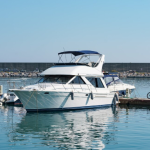Overview of the Eco Impact of Sport Bikes
Sport bikes are making waves in the realm of urban transportation sustainability thanks to their comparatively low eco impact. These nimble vehicles typically consume less fuel than cars and emit fewer pollutants per mile, primarily due to their smaller engines and efficient fuel consumption. The concept of replacing traditional vehicles with sport bikes, especially in densely populated urban areas, is gaining popularity as it aligns with green initiatives and reduces the environmental burden.
When considering the environmental footprint, sport bikes stand out positively against larger vehicles like cars, SUVs, and trucks. Cars emit higher levels of greenhouse gases and consume more resources. Meanwhile, sport bikes are contributing to reduced congestion on bustling city streets. A smaller and more maneuverable vehicle makes for smoother traffic flow and fewer traffic jams.
Topic to read : 2023 Guide to UK Sport Bike Helmet Safety Standards: What You Need to Know
The move towards sustainability in urban transportation is crucial. Cities emit large amounts of carbon dioxide due to extensive vehicle use. Therefore, integrating more sport bikes could prove an effective measure in curbing emissions. This change not only benefits the environment but also decreases individual carbon footprints. Overall, the shift toward sport bikes supports a cleaner, more sustainable urban future. With their ability to cut emissions and alleviate congestion, sport bikes are an eco-friendly alternative that meets modern environmental demands.
Emissions and Energy Consumption
Understanding the CO2 emissions of motorcycles, especially sport bikes, in comparison to cars, reveals some nuanced insights. While cars tend to emit more CO2 on average due to their larger engines and heavier weight, smaller and more fuel-efficient sport bikes provide a greener alternative when measured per mile.
This might interest you : Essential Guidelines for Safely Towing Your Sports Bike on UK Motorways: A Comprehensive Guide
Different types of sport bikes exhibit varied fuel efficiency levels. For instance, sports tourers, known for their aerodynamic designs and lightweight builds, typically achieve higher miles per gallon (mpg) compared to supersport models, which often prioritize speed over efficiency. This disparity showcases that not all sport bikes are created equal in terms of energy use.
Analysing energy consumption patterns in urban settings indicates that sport bikes generally demonstrate less long-term energy consumption compared to cars. They benefit from their ability to weave through traffic efficiently and require less fuel during frequent stop-and-go situations.
It’s crucial to note, however, that reducing emissions and energy use goes beyond simply choosing a sport bike over a car. Maintenance practices, riding habits, and technological advancements in battery technology are influential factors. Adopting modern innovations and remaining informed about optimal eco-riding techniques can further lower your carbon footprint, promoting a more sustainable future.
Pollution Perspective
In the bustling environments of many cities, the presence of urban pollution is significantly affected by various forms of transportation, including sport bikes. These two-wheeled machines, while exhilarating, contribute notably to air quality deterioration. Urban air pollution from sport bikes is primarily due to emissions of nitrogen oxides and particulate matter, which are by-products of fuel combustion. In densely populated areas, this can lead to increased respiratory problems among city dwellers.
Not only do sport bikes impact air quality, but they also contribute to noise pollution, which is often overlooked. The noise pollution from motorcycles can disturb urban tranquility, leading to stress and sleep disturbances for residents. Cities have taken steps by implementing regulations to curb excessive noise, requiring motorcycles to meet specific sound-level standards.
Fortunately, advancements in technology and rider awareness offer solutions to mitigate these impacts. Innovations such as electric sport bikes provide a quieter, more environmentally friendly alternative, reducing both air and noise pollution. Furthermore, riders can adopt eco-friendly riding habits, such as maintaining optimal engine performance and reducing idling times, to lessen their environmental footprint. By embracing these improvements, urban populations can enjoy enhanced air quality and reduced noise in cityscapes.
Urban Planning and Sport Bikes
Urban mobility has become an increasingly pressing concern in many cities around the world. Sport bikes play a pivotal role in these strategies due to their agility and efficiency in navigating crowded urban environments. These motorcycles not only offer a compact form of transportation but also contribute to reducing traffic congestion and pollution when properly integrated into infrastructure plans.
Motorcycle Infrastructure in UK Cities
The UK presents a fascinating case study on the integration of sport bikes within urban settings. Many cities have invested in motorcycle-friendly infrastructure such as dedicated bike lanes, ample parking spaces, and even specific commuting incentives for riders. These measures illustrate a commitment to accommodating a broader range of transportation modes, ensuring that sport bikes are not only part of the urban landscape but are safely and efficiently woven into it.
Integrating Sport Bikes into Urban Planning
To seamlessly blend sport bikes into urban planning, several recommendations should be considered:
- Designating dedicated lanes and parking for motorcycles.
- Implementing traffic management systems that consider the unique dynamics of motorcycles.
- Encouraging policies that support motorcycle use, such as reduced tolls or insurance incentives.
These approaches not only enhance urban mobility but also promote safer, more effective transportation systems across cities. As more urban planners recognize the potential of sport bikes, infrastructure will evolve to better support motorcycle-friendly cities, creating dynamic, adaptable urban landscapes.
Case Studies and Real-World Examples
In the pursuit of sustainable transportation initiatives, certain cities have emerged as frontrunners by adopting innovative practices related to sport bikes. These initiatives not only cater to environmental benefits but also focus on enhancing urban mobility. A standout example is Amsterdam, where a blend of pedal power and electric sport bikes constitutes a major sustainable transportation initiative. With dedicated lanes and charging stations, Amsterdam has significantly reduced urban congestion and lowered carbon emissions.
The city of Barcelona offers another environmental impact example. Here, a shared sport bike scheme encourages residents to opt for two-wheelers rather than cars. The results indicate not just a decline in air pollution but also a remarkable improvement in traffic flow and public health due to reduced vehicle consumption.
In terms of case studies, Oslo has implemented a comprehensive plan promoting motorcycle use. This proactive approach includes incentives such as tax breaks for electric bike purchases and specific parking benefits for eco-friendly vehicles. These policies demonstrated how coalescing public incentives with motorbike infrastructure development can lead to more sustainable cities.
A critical lesson from these case studies is the necessity of tailored solutions, wherein local needs and specific challenges are taken into account. This allows cities to effectively leverage sport bikes as a viable tool for reducing environmental impacts while promoting a cleaner, greener future.
Expert Insights and Opinions
Let us delve into the nuanced world of expert interviews to illuminate the intersection of sport bikes, environmental policies, and sustainability. Environmental scientists’ perspectives offer a critical lens on the role of sport bikes in sustainable transportation. While often seen as less environmentally friendly than bicycles or public transport, sport bikes may still contribute to reducing carbon footprints compared to traditional cars. Their nimble nature and lower fuel consumption can aid in this effort.
Interviews with urban planners highlight a complex dynamic in motorcycle regulations. Urban policies often emphasize reducing vehicular emissions and promoting sustainability; yet, sport bikes encounter stringent regulations due to safety and emissions concerns. Planners aim to balance fostering sustainability and ensuring public safety, often promoting infrastructure that supports both cyclists and motorcyclists.
Motorcycle advocacy groups also champion an eco-friendly transition by supporting the adoption of sustainable practices within the community. Advocacy focuses on encouraging eco-conscious riding habits and embracing innovations, such as electric sport bikes, which hold promise in minimizing environmental impact while retaining the thrill of the ride. By engaging stakeholders, these groups play a pivotal role in shaping a future where sport bikes align more closely with sustainability objectives.
Practical Tips for Eco-Conscious Riding
Focusing on eco-friendly riding tips can significantly reduce your environmental impact. As a rider, your journey to more sustainable motorcycle practices begins with some basic adjustments.
Start by considering eco-friendly modifications for your sport bike. Opt for energy-efficient engines and tyres that have a long lifespan. Upgrading to high-performance air filters can also improve your motorcycle’s efficiency, further reducing emissions. These minor adjustments can play a significant role in greening your rides.
Incorporating best practices while riding is crucial. Ensure regular maintenance of your bike, such as timely oil changes and keeping tires inflated. This not only helps in maintaining optimal fuel efficiency but also minimizes harmful emissions. Additionally, avoiding aggressive acceleration and braking can lead to smoother rides, conserving more energy.
Engaging in community efforts and resources can enhance your journey towards sustainable riding. Joining local rider groups focused on eco-conscious practices provides an excellent platform for sharing knowledge and tools for sustainable riding. These networks also offer rider education materials, streams of information where you can learn more about eco-friendly practices.
Remember, being a responsible rider means considering the larger impact and making informed, proactive choices that contribute to lessening your carbon footprint.













